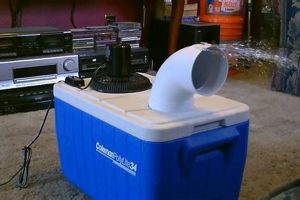A compact, self-constructed food preparation area represents a solution for limited spaces or cost-conscious individuals. Such an area typically includes a small sink, countertop, and storage solutions, designed and assembled by the user rather than purchased as a pre-built unit. Examples range from repurposing existing furniture to creating entirely new structures using readily available materials.
The appeal of such setups lies in their adaptability and economic viability. They provide functionality in areas where a full-sized kitchen is impractical or unaffordable, like basement apartments, home offices, or recreational spaces. Historically, resourcefulness in creating functional living spaces has been a necessity, leading to diverse and innovative approaches to kitchen design and construction using limited resources.
The subsequent sections will explore various design considerations, material options, construction techniques, and essential appliances for constructing a customized and functional small-scale cooking and cleaning area.
Guidance on Small Food Preparation Area Construction
The following provides actionable advice for planning and executing a self-assembled compact food preparation area.
Tip 1: Space Assessment: Before commencement, a thorough evaluation of the available physical footprint is critical. Precise measurements of width, depth, and height will dictate design limitations and influence component selection.
Tip 2: Functionality Prioritization: Determine the core functions. Will the area be used primarily for beverage preparation, reheating pre-made meals, or light cooking? This assessment directly affects the selection of appliances and required storage space.
Tip 3: Water Supply and Drainage: Secure proper plumbing access. Connection to a potable water supply and a sanitary drain line is essential for sink functionality. Consider the complexity and cost of plumbing modifications before proceeding.
Tip 4: Electrical Requirements: Assess electrical load capacity. Countertop appliances necessitate adequately grounded outlets. Consult a qualified electrician to ensure the existing wiring meets safety standards and the power demands of planned appliances.
Tip 5: Material Selection: Choose durable and water-resistant materials. Countertops should withstand moisture and heat. Consider laminate, solid surface, or sealed butcher block. Cabinetry should be constructed from moisture-resistant plywood or melamine.
Tip 6: Ventilation Considerations: In confined spaces, adequate ventilation is paramount. If cooking involves heat or steam, explore options for installing a small exhaust fan or range hood to prevent moisture buildup and odor accumulation.
Tip 7: Storage Optimization: Maximize vertical space with shelving units. Utilize wall-mounted organizers for utensils and small items. Under-sink cabinets provide valuable storage for cleaning supplies and frequently used cookware.
Tip 8: Code Compliance: Verify adherence to local building codes. Plumbing and electrical installations often require permits and inspections. Neglecting these requirements can lead to costly remediation in the future.
Adhering to these principles will facilitate the construction of a safe, functional, and code-compliant small food preparation zone, effectively addressing the limitations of space and budget.
The subsequent section will delve into specific design examples and case studies demonstrating successful implementations of these principles.
1. Space Optimization
Space optimization is a foundational element in the conceptualization and execution of a self-assembled food preparation area. Limited square footage frequently necessitates this type of construction, making efficient use of available space paramount. Failure to adequately optimize space can result in a cramped, dysfunctional area that fails to meet its intended purpose. For instance, utilizing a corner sink design can maximize counter space in a small area, while vertical storage solutions, such as shelving units, capitalize on unused wall space. The selection of compact appliances, like a combination microwave-convection oven, further contributes to efficient space utilization.
Efficient utilization of space directly impacts functionality and workflow within the preparation area. Poor space planning may result in inadequate countertop area for food preparation, insufficient storage for essential utensils and ingredients, and compromised access to appliances. A practical example is the implementation of pull-out cutting boards or fold-down tables that provide temporary workspace when needed but retract to conserve space when not in use. Similarly, shallow depth cabinets can provide storage without encroaching excessively into the room. Understanding the principles of ergonomic design is essential for creating a workspace that minimizes unnecessary movement and maximizes productivity within a compact footprint.
In conclusion, space optimization is not merely an aesthetic consideration but a critical determinant of the overall success of a self-assembled compact food preparation zone. Addressing space constraints through careful planning, strategic appliance selection, and innovative storage solutions transforms a potentially cramped and unusable area into a functional and efficient workspace. Overlooking this principle can result in a substandard outcome that undermines the value and utility of the entire endeavor.
2. Plumbing Integration
Plumbing integration is a critical, often underestimated, aspect of constructing a self-assembled compact food preparation area. Its successful execution directly determines the functionality and usability of the installed sink, a central element for washing, cleaning, and food preparation. Incorrect or inadequate plumbing can lead to leaks, insufficient water pressure, or even unsanitary conditions, rendering the entire area unusable. For instance, failing to properly connect drain lines can result in wastewater backup, causing damage to surrounding structures and posing health risks.
The integration process involves several key steps, including identifying suitable water supply lines, installing drain pipes with appropriate slope, and ensuring proper venting to prevent sewer gases from entering the living space. One common challenge is connecting to existing plumbing systems, especially in older buildings, which may require adapters or modifications to ensure compatibility. The selection of appropriate pipe materials, such as PVC or PEX, also depends on local building codes and water quality. Furthermore, the installation of a properly sized P-trap under the sink is crucial for trapping debris and preventing odors. Neglecting any of these considerations can compromise the integrity of the plumbing system.
In conclusion, plumbing integration is not merely an ancillary
task but an integral component of a functional and safe self-assembled food preparation space. From selecting the correct materials and fittings to adhering to local building codes, a thorough understanding of plumbing principles is essential. Addressing plumbing challenges proactively ensures the longevity and usability of the constructed area and prevents potentially costly and hazardous issues down the line. A poorly executed plumbing system can negate all other efforts, highlighting its importance in the overall project.
3. Electrical Safety
Electrical safety is a paramount consideration in the creation of a self-assembled compact food preparation zone. The inherent risks associated with water and electricity in close proximity necessitate strict adherence to safety protocols. A failure to prioritize electrical safety can result in severe consequences, ranging from electrical shock and fire hazards to equipment damage and potential loss of life. For example, improperly grounded outlets near a sink can create a pathway for electrical current through a person touching a faucet, leading to electrocution. The presence of appliances such as microwaves, refrigerators, and blenders further increases the electrical load and complexity of the system, requiring careful planning and execution.
Practical applications of electrical safety principles within such projects involve several critical measures. These include the use of Ground Fault Circuit Interrupters (GFCIs) in all outlets near water sources to immediately cut off power in the event of a fault. Adherence to National Electrical Code (NEC) guidelines for wiring, circuit capacity, and appliance placement is essential. The employment of properly sized and rated wiring to handle the anticipated electrical load prevents overheating and potential fire hazards. Furthermore, regular inspection of wiring and outlets, and avoidance of extension cords as permanent solutions, contribute to a safe electrical environment. An example is ensuring that the circuit breaker amperage matches the wire gauge to prevent overloading the circuit.
In conclusion, electrical safety is not an optional consideration but a fundamental requirement for any self-assembled compact food preparation area. Proactive measures, including proper grounding, GFCI installation, code compliance, and regular maintenance, mitigate risks and ensure a safe operating environment. The potential dangers associated with electricity demand meticulous attention to detail and, in situations where expertise is lacking, the involvement of a qualified electrician. Neglecting electrical safety can lead to severe consequences, underscoring the critical need for prioritizing this aspect of construction.
4. Material Durability
Material durability is a paramount consideration in the design and construction of self-assembled compact food preparation areas. Given the inherent exposure to moisture, heat, and physical impact within these spaces, the selection of robust and resilient materials directly impacts the longevity, functionality, and overall value of the structure. Substandard material choices can lead to premature degradation, necessitating costly repairs or complete replacement, thus undermining the economic advantages of a do-it-yourself approach.
- Countertop Resistance
Countertops, the primary work surfaces, require high resistance to scratches, stains, and heat. Materials such as laminate, solid surface, or butcher block (when properly sealed) offer varying degrees of durability. Laminate provides an economical option but may be susceptible to water damage if seams are not properly sealed. Solid surface materials, like Corian, are non-porous and resistant to stains but can be more expensive. Butcher block offers a warm aesthetic but requires regular maintenance to prevent water damage and bacterial growth.
- Cabinetry Construction
Cabinetry forms the structural foundation and storage component, demanding resistance to moisture and weight. Plywood, particularly marine-grade plywood, provides superior moisture resistance compared to particleboard, which can swell and disintegrate when exposed to water. Solid wood offers durability but is more prone to warping and cracking in humid environments. Melamine-faced chipboard provides a cost-effective alternative for cabinet interiors but should be used cautiously in areas prone to water exposure.
- Plumbing Fixture Longevity
Plumbing fixtures, including sinks and faucets, should be constructed from materials resistant to corrosion and wear. Stainless steel sinks offer excellent durability and resistance to staining, while cast iron sinks provide a more robust option but require careful maintenance to prevent rust. Faucets constructed from solid brass or stainless steel offer superior longevity compared to those made from plated plastic or zinc alloys. Choosing fixtures designed for commercial use often provides enhanced durability and reliability.
- Hardware Endurance
Hardware components, such as hinges, drawer slides, and door pulls, are subject to frequent use and potential stress. Selecting hardware made from solid metal, such as stainless steel or brass, ensures smooth operation and prevents premature failure. Inexpensive hardware made from plastic or thin metal can quickly wear out or break, compromising the functionality and aesthetics of the entire structure. Soft-close hinges and full-extension drawer slides offer enhanced durability and convenience.
The long-term success of a self-constructed compact food preparation area hinges on the careful selection of materials that can withstand the demands of regular use. By prioritizing durability, individuals can maximize the lifespan of their creation, minimizing the need for repairs or replacements and ensuring a functional and aesthetically pleasing addition to their living space. The initial investment in higher-quality materials typically yields significant returns in terms of longevity and reduced maintenance requirements. The examples provided underscore how diligent selection contributes directly to the overall value proposition of such projects.
5. Cost Efficiency
Cost efficiency constitutes a primary motivator for undertaking self-assembled compact food preparation area projects. The ability to control expenses through material selection, labor input, and design choices offers a significant economic advantage over purchasing pre-fabricated units or hiring professional contractors. This approach allows individuals to tailor the project to their budgetary constraints, maximizing value and minimizing financial outlay.
- Material Sourcing and Selection
The choice of materials directly impacts overall project cost. Opting for reclaimed lumber, repurposed cabinetry, or discounted tile can significantly reduce expenses compared to purchasing new, high-end materials. Strategic sourcing through online marketplaces, salvage yards, or local retailers allows for price comparison and negotiation. The trade-off often involves increased labor for preparation or modification, but the resulting cost savings can be substantial. For instance, using reclaimed wood
requires sanding and finishing, while purchasing new lumber is ready to install but costs more. - Labor Contribution and Skill Set
The extent to which the individual performs the labor themselves dramatically influences the final cost. Performing tasks such as demolition, framing, plumbing, and electrical work eliminates the expense of hiring specialized contractors. However, this necessitates possessing the requisite skills, tools, and knowledge of building codes. Utilizing online tutorials, instructional videos, and DIY workshops can help develop these skills, but it is crucial to accurately assess one’s capabilities to avoid costly errors or safety hazards. In cases where specific expertise is lacking, hiring a licensed professional for critical tasks, such as electrical wiring, is a prudent investment that ensures safety and compliance.
- Appliance and Fixture Choices
The selection of appliances and fixtures offers another avenue for cost control. Opting for smaller, energy-efficient appliances can reduce both the initial purchase price and ongoing operating expenses. Refurbished appliances, when available from reputable sources, can provide a cost-effective alternative to new models. Similarly, choosing basic plumbing fixtures and hardware over high-end designer options can yield significant savings. The focus should be on functionality and durability rather than purely aesthetic considerations, particularly when budgetary constraints are a primary concern. For instance, a compact refrigerator without advanced features will be less expensive than a full-sized, smart refrigerator.
- Design Simplicity and Scale
The complexity and scale of the design directly correlate with project cost. Simplifying the design by minimizing custom cabinetry, intricate tile patterns, or complex plumbing configurations can significantly reduce expenses. Opting for a smaller footprint and avoiding unnecessary features allows for a more streamlined and affordable construction process. A minimalist approach, focusing on essential functionality and efficient space utilization, often results in a more cost-effective outcome. An example is using open shelving instead of enclosed cabinets, which requires less material and labor.
The aforementioned facets underscore the inherent cost-efficiency potential of constructing a self-assembled compact food preparation area. By strategically managing material sourcing, labor input, appliance selection, and design complexity, individuals can realize significant savings compared to conventional kitchen renovation or purchase options. However, it is essential to balance cost considerations with safety, code compliance, and the ultimate functionality of the space to ensure a successful and long-lasting outcome.
Frequently Asked Questions
The following addresses common inquiries regarding the planning, construction, and maintenance of self-assembled compact food preparation areas.
Question 1: Is specialized expertise required to construct a functioning small-scale food preparation area?
While basic carpentry skills are beneficial, many projects can be completed with readily available resources and online tutorials. However, electrical and plumbing work often necessitate the involvement of licensed professionals to ensure safety and code compliance. Improperly installed electrical wiring or plumbing can pose significant hazards.
Question 2: What are the essential components of a basic compact food preparation area?
A functional setup typically includes a sink with running water, a countertop for food preparation, storage space for utensils and ingredients, and at least one electrical outlet for appliances. Depending on usage requirements, a small refrigerator, microwave, or cooktop may also be included.
Question 3: How can space be maximized in a small self-constructed food preparation area?
Employing vertical storage solutions, such as shelving units, is essential. Compact appliances, like a combination microwave-convection oven, can save valuable counter space. Corner sinks and pull-out cutting boards also contribute to efficient space utilization. Prioritize multi-functional items wherever possible.
Question 4: What building codes or regulations must be considered during construction?
Local building codes typically address plumbing, electrical, and structural requirements. Permits may be required for plumbing and electrical modifications. It is imperative to consult local building authorities to ensure compliance with all applicable regulations. Failure to comply can result in fines and mandatory remediation.
Question 5: What materials are suitable for countertops and cabinetry in a small cooking and cleaning zone?
Countertops should be durable, water-resistant, and easy to clean. Laminate, solid surface materials, and sealed butcher block are common choices. Cabinetry should be constructed from moisture-resistant plywood or melamine to prevent warping and water damage. Solid wood is an option, but requires careful sealing and maintenance.
Question 6: How can the cost of building a small food preparation area be minimized?
Utilize reclaimed materials, repurpose existing furniture, and perform as much of the labor as possible. Compare prices from multiple suppliers to secure the best deals on materials and appliances. Focus on essential functionality and avoid unnecessary embellishments. Consider purchasing refurbished appliances from reputable vendors.
These FAQs provide a foundation for informed decision-making in constructing a self-assembled small cooking and cleaning area. Thorough research and careful planning are crucial for a successful outcome.
The next section will present case studies illustrating diverse implementations of these principles in real-world scenarios.
Conclusion
This exploration of self-assembled compact food preparation areas has underscored the importance of strategic planning, informed material selection, and rigorous adherence to safety protocols. The success of such a project hinges on balancing cost-effectiveness with functionality, durability, and compliance with local regulations. The practical considerations of space optimization, plumbing integration, and electrical safety are not mere afterthoughts, but rather integral components that determine the ultimate viability and longevity of the structure.
Individuals considering this endeavor are encouraged to approach it with diligence and a commitment to thorough research. The creation of a functional and safe small-scale cooking and cleaning zone requires more than just basic construction skills; it demands a comprehensive understanding of design principles, building codes, and the potential hazards associated with water and electricity. A well-executed space offers a significant enhancement to living arrangements; a poorly executed one can create persistent problems. Therefore, prudent planning and execution are paramount.







